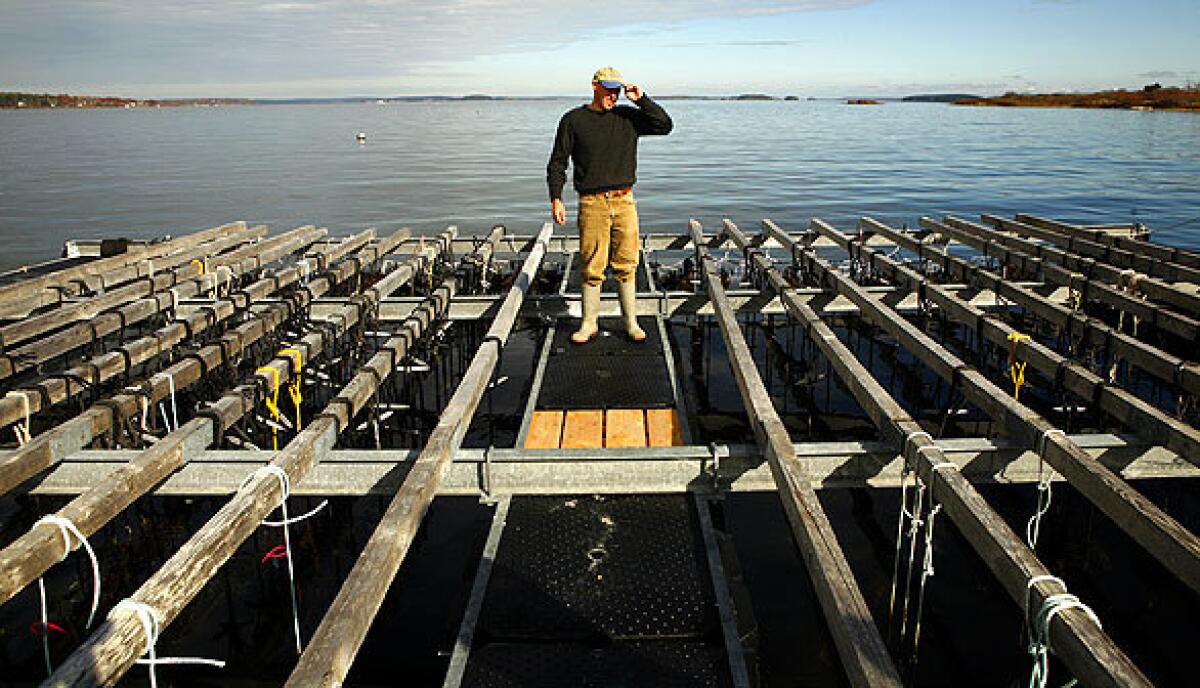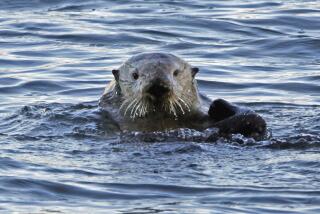A crop from the ocean floor

Paul Dobbins and Tollef Olson admit they still have a kink in their scheme to use seaweed to revolutionize American eating habits, clean the environment, lower the federal trade deficit and make themselves fabulously rich.
Call it the yuck factor.
“It tastes better than it looks,” said Olson, holding a shimmering frond of brown horsetail kelp he had just plucked from the cold gray waters of Casco Bay. “Really.”
Dobbins and Olson run what is believed to be America’s only commercial kelp farm. Inspired by mega-aquaculture sites in Asia, and a $7-billion global seaweed industry, the two entrepreneurs started cultivating kelp here last year and have begun marketing it as an exotic frozen vegetable.
“It’s a giant brown algae in the water, but it turns bright green when it’s cooked,” Olson said. “Think kelp noodles. And kelp salad. And kelp slaw.”
The aqua-farmers go to work each day in a 41-year-old lobster boat, chugging between rugged islands and rocky outcrops. They usually wear wet suits and scuba gear to tend their underwater crop by hand. On wintry days, they light a wood-burning stove below deck to keep warm.
As the boat bobbed off Bangs Island one recent morning, they tied three species of kelp seedlings into long mesh sleeves. They lowered each sleeve about 25 feet into the tidal current on ropes tied to a large raft that was anchored to the bottom near the last few lobster traps of the season.
By spring, each frond should be 6 to 8 feet long. The kelp will be cut by hand, briefly boiled to kill bacteria, sliced into spaghetti- or fettuccine-like strips, and frozen in plastic bags.
The company, Ocean Approved, sold the first year’s crop to half a dozen Whole Foods Markets and other high-end natural food stores in Boston, Los Angeles and Portland, Maine, where it goes for up to $4.60 for 4 ounces.
Mixed with coleslaw, the kelp tastes tangy and crunchy, less pungent than dried seaweed. It does not taste fishy.
Ocean Approved plans to expand production tenfold next year using underwater acreage it has leased from Maine’s Department of Marine Resources. It will start a nursery for kelp seedlings that can be transplanted to long lines on the seafloor, and then hauled up and harvested on barges, rather than in the water.
“It’s a great stride forward,” said Robert Morse, owner of North American Kelp, which collects kelp the old-fashioned way -- from rocks in tidal inlets along the central Maine coast -- for animal feed and fertilizer. “Let’s hope it takes off. It will create a lot of jobs.”
“What’s unique is they are producing convenience food, American food, like fish sticks,” agreed David Myslabodski, who runs Great SeaVegetables, a consulting firm in Rockland, Maine. “It’s a novelty. It doesn’t exist anywhere else.”
Scientists who study marine algae, called phycologists, also are watching closely.
“I’m absolutely persuaded it has huge potential,” said John Forster, an aquaculture consultant based in Port Angeles, Wash. “Certainly it’s a niche right now. But the idea that human beings won’t eat more marine vegetables in the future seems very improbable.”
The oceans contain more than 9,000 species of seaweed, including about 300 of kelp. Most are not edible.
Seaweed doesn’t require arable land, fresh water or fertilizer. Kelp grows swiftly -- 2 feet a day in some species -- and produces no runoff or erosion. It cleanses the water of excess nutrients and absorbs carbon dioxide, a greenhouse gas that contributes to global warming.
“This isn’t rocket science,” said professor Charles Yarish, a marine biologist at the University of Connecticut and an unpaid advisor to the new company.
“Seaweed performs a very important ecological function. Farming does it in a more sustainable way.”
The idea is hardly new. In 1966, Time magazine predicted that by the year 2000, “huge fields of kelp and other kinds of seaweed will be tended by undersea ‘farmers’ -- frogmen who will live for months at a time in submerged bunkhouses.” The seaweed probably would be “regenerated chemically to taste like anything from steak to bourbon.”
Seaweed is a booming global business even if it still tastes like seaweed. About 15 million metric tons were harvested in about 35 countries in 2007, nearly double the total of a decade earlier, according to the U.N.’s Food and Agriculture Organization.
China is the largest producer and exporter, and nearly all its crop is farmed in operations that fill entire bays and estuaries. Various species are added to noodles in the Philippines, mixed with oats to bake bread in Wales, added to nutmeg and milk for a beverage in Belize, and consumed in soups, garnishes, snacks and with sushi in Japan.
Kelp is processed to extract food gums -- texturizing agents called agars, alginates and carrageenans. The additives make toothpaste thick, yogurt creamy, beer foamy and skin moisturizers moist, among countless other uses.
“Most Americans don’t know it, but they already consume seaweed products every day,” said Robert Vadas, professor of marine sciences at the University of Maine. “Most of it is imported.”
America once had a major kelp industry based in Southern California.
During World War I, some 1,500 companies harvested towers of giant kelp, the world’s largest seaweed, from coastal beds between San Diego and Eureka to provide potash for gunpowder. Most shut down when their contracts expired after the war.
Soon after, the nation’s largest kelp company, known as Kelco, began operating ocean-going barges that cut and collected hundreds of tons of giant kelp each day off San Diego. A factory in the city’s Barrio Logan neighborhood processed it for food additives, pharmaceuticals, chemicals and other industries.
Others saw even greater possibilities.
Energy activists pushed seaweed as a renewable source of biofuel to ease America’s reliance on imported oil. The idea was to ferment kelp to generate methane, or process it to produce ethanol, as is done with corn and sugar cane.
But the marine biofuel industry never proved viable. Nor did proposals to create vast mid-ocean rafts of floating kelp to soak up greenhouse gases. ISP Alginates closed its Kelco plant in San Diego in 2005 and moved the operation to Scotland, rather than meet California’s environmental regulations.
Today, only a handful of smaller U.S. companies harvest seaweed. Those in California chiefly provide feed for abalone farms. Those in Maine mostly supply fertilizer, livestock feed and dietary supplements.
“People who eat dried seaweed are pretty dedicated to it,” said Ellen Andrews, marketing manager for Maine Coast Sea Vegetables, which sells powdered seaweed and Kelp Krunch Bars to natural food stores and health clinics. “It’s very healthy.”
Some fans extol kelp’s supposed ability to combat everything from cancer and HIV infections to radiation poisoning and high blood pressure. Scientists say those claims are unproven at best.
“It’s a mineral supplement, not a miracle food,” said John Pease, professor emeritus of biology at UC Santa Cruz.
Olson, 53, founded his kelp farm after working as a treasure hunter, commercial fisherman and mussel grower. Dobbins, 45, was general manager of a bio-tech company before he heard Olson pitch kelp at a local supermarket.
“I see this as a potential way to create a whole new fishery in Maine,” said Dobbins.
He said they have invested about $300,000 so far. “We’re still losing our shirts,” he added.
Whether Americans will buy frozen kelp from the grocer as readily as frozen spinach remains to be seen. Rebranding may be the key.
“When you hear the term seaweed, you don’t have a positive reaction,” Yarish said. “You think about all that slimy crap on the beach and say, ‘Get it away from me.’ That’s why I like to say sea vegetable. It sounds much nicer.”
More to Read
Start your day right
Sign up for Essential California for news, features and recommendations from the L.A. Times and beyond in your inbox six days a week.
You may occasionally receive promotional content from the Los Angeles Times.






